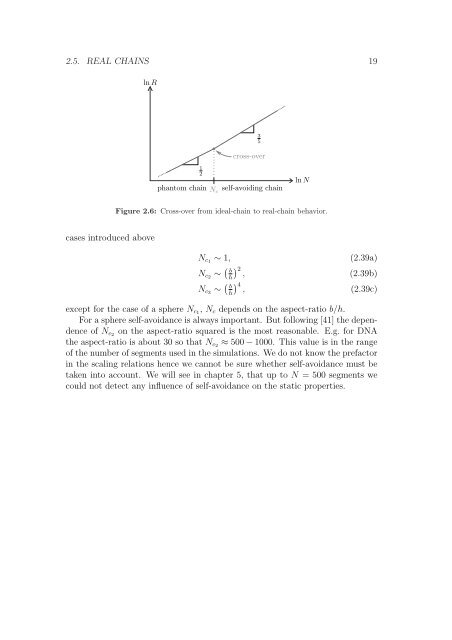Polymers in Confined Geometry.pdf
Polymers in Confined Geometry.pdf
Polymers in Confined Geometry.pdf
Create successful ePaper yourself
Turn your PDF publications into a flip-book with our unique Google optimized e-Paper software.
2.5. REAL CHAINS 19<br />
ln R<br />
cases <strong>in</strong>troduced above<br />
1<br />
2<br />
phantom cha<strong>in</strong><br />
Nc<br />
3<br />
5<br />
cross-over<br />
self-avoid<strong>in</strong>g cha<strong>in</strong><br />
ln N<br />
Figure 2.6: Cross-over from ideal-cha<strong>in</strong> to real-cha<strong>in</strong> behavior.<br />
Nc1 ∼ 1, (2.39a)<br />
Nc2 ∼ <br />
b 2<br />
, (2.39b)<br />
h<br />
Nc3 ∼ <br />
b 4<br />
, (2.39c)<br />
h<br />
except for the case of a sphere Nc1, Nc depends on the aspect-ratio b/h.<br />
For a sphere self-avoidance is always important. But follow<strong>in</strong>g [41] the dependence<br />
of Nc2 on the aspect-ratio squared is the most reasonable. E.g. for DNA<br />
the aspect-ratio is about 30 so that Nc2 ≈ 500 − 1000. This value is <strong>in</strong> the range<br />
of the number of segments used <strong>in</strong> the simulations. We do not know the prefactor<br />
<strong>in</strong> the scal<strong>in</strong>g relations hence we cannot be sure whether self-avoidance must be<br />
taken <strong>in</strong>to account. We will see <strong>in</strong> chapter 5, that up to N = 500 segments we<br />
could not detect any <strong>in</strong>fluence of self-avoidance on the static properties.













